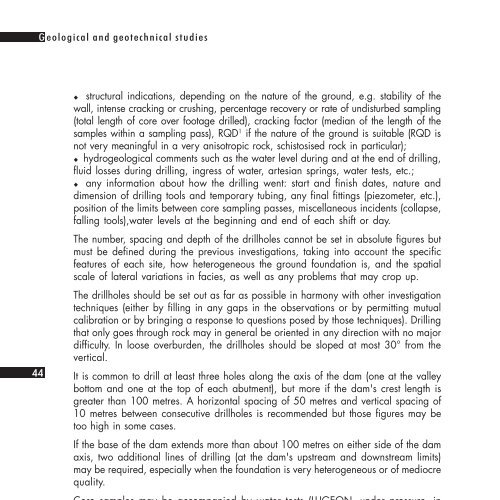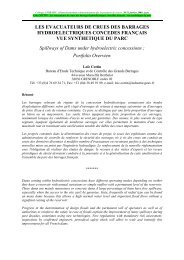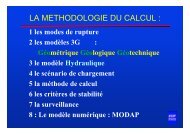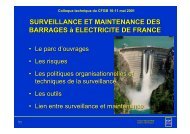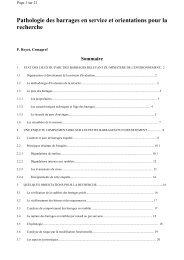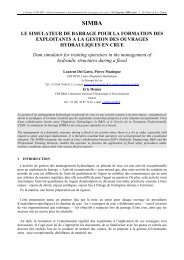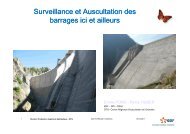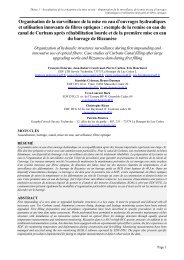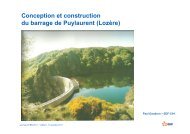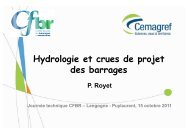SMALL DAMS
SMALL DAMS - Comité Français des Barrages et Réservoirs
SMALL DAMS - Comité Français des Barrages et Réservoirs
- No tags were found...
You also want an ePaper? Increase the reach of your titles
YUMPU automatically turns print PDFs into web optimized ePapers that Google loves.
G eological and geotechnical studies<br />
44<br />
!" structural indications, depending on the nature of the ground, e.g. stability of the<br />
wall, intense cracking or crushing, percentage recovery or rate of undisturbed sampling<br />
(total length of core over footage drilled), cracking factor (median of the length of the<br />
samples within a sampling pass), RQD 1 if the nature of the ground is suitable (RQD is<br />
not very meaningful in a very anisotropic rock, schistosised rock in particular);<br />
!"hydrogeological comments such as the water level during and at the end of drilling,<br />
fluid losses during drilling, ingress of water, artesian springs, water tests, etc.;<br />
!" any information about how the drilling went: start and finish dates, nature and<br />
dimension of drilling tools and temporary tubing, any final fittings (piezometer, etc.),<br />
position of the limits between core sampling passes, miscellaneous incidents (collapse,<br />
falling tools),water levels at the beginning and end of each shift or day.<br />
The number, spacing and depth of the drillholes cannot be set in absolute figures but<br />
must be defined during the previous investigations, taking into account the specific<br />
features of each site, how heterogeneous the ground foundation is, and the spatial<br />
scale of lateral variations in facies, as well as any problems that may crop up.<br />
The drillholes should be set out as far as possible in harmony with other investigation<br />
techniques (either by filling in any gaps in the observations or by permitting mutual<br />
calibration or by bringing a response to questions posed by those techniques). Drilling<br />
that only goes through rock may in general be oriented in any direction with no major<br />
difficulty. In loose overburden, the drillholes should be sloped at most 30° from the<br />
vertical.<br />
It is common to drill at least three holes along the axis of the dam (one at the valley<br />
bottom and one at the top of each abutment), but more if the dam's crest length is<br />
greater than 100 metres. A horizontal spacing of 50 metres and vertical spacing of<br />
10 metres between consecutive drillholes is recommended but those figures may be<br />
too high in some cases.<br />
If the base of the dam extends more than about 100 metres on either side of the dam<br />
axis, two additional lines of drilling (at the dam's upstream and downstream limits)<br />
may be required, especially when the foundation is very heterogeneous or of mediocre<br />
quality.<br />
Core samples may be accompanied by water tests (LUGEON, under pressure, in<br />
rock; LEFRANC, by natural flow, in loose overburden), especially on the axis of any<br />
watertight elements. Getting meaningful results from water tests requires the use of<br />
suitable equipment complying with standardised operating conditions and carrying<br />
out tests in a rational manner:<br />
!"drilling must be exclusively with clear water (no bentonite or biodegradable slurry)<br />
and before each test the drillhole wall must be cleaned (by successive passes of the<br />
tool with water injected in until clear water comes out at the drill head), in order to<br />
remove any fine deposits ("cake") that could clog the pores and cracks responsible<br />
for permeability and thereby distort measurements;<br />
1. Rock Quality Designation = total of the lengths of the core samples greater than 10 cm / length of the<br />
corresponding drilling.


